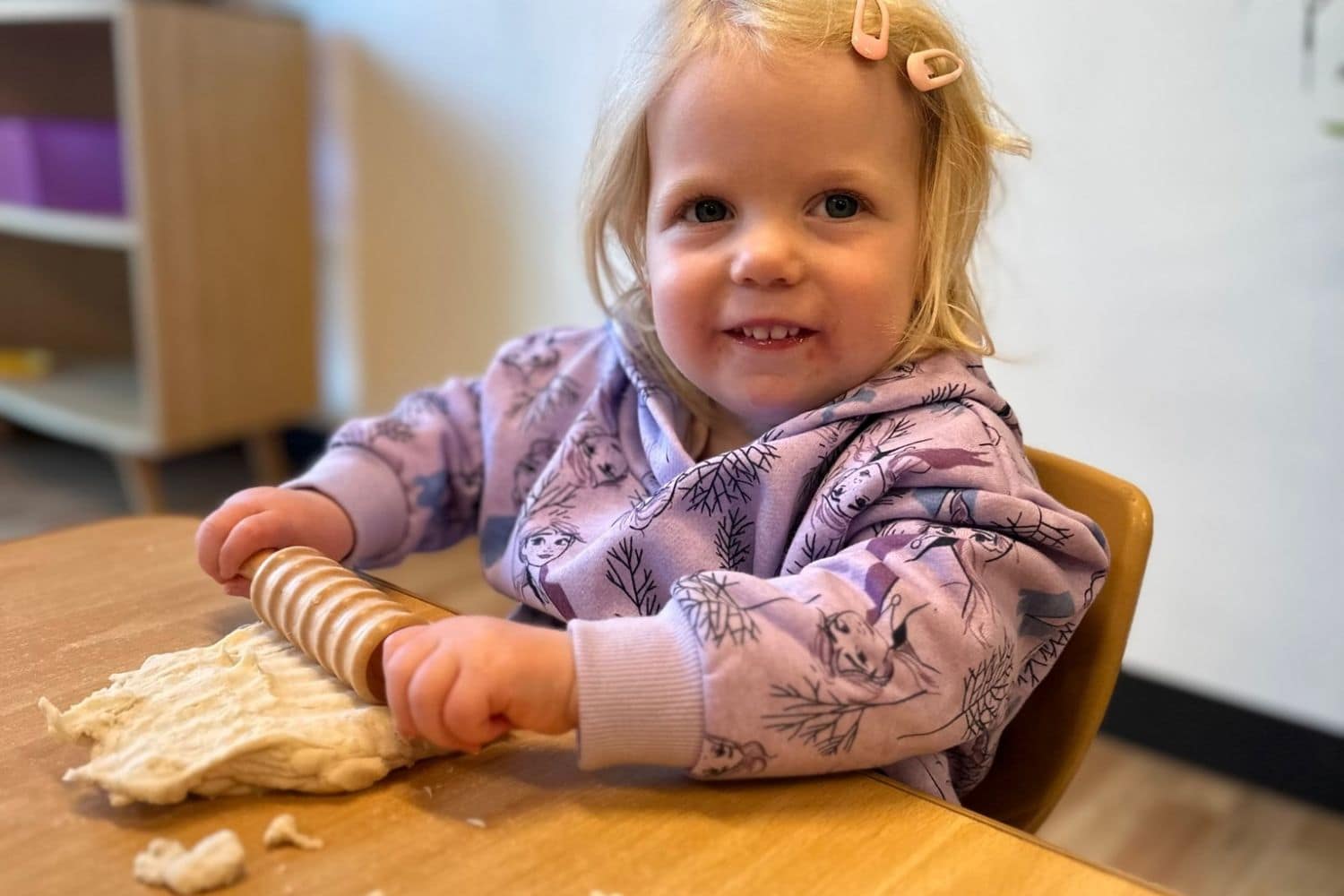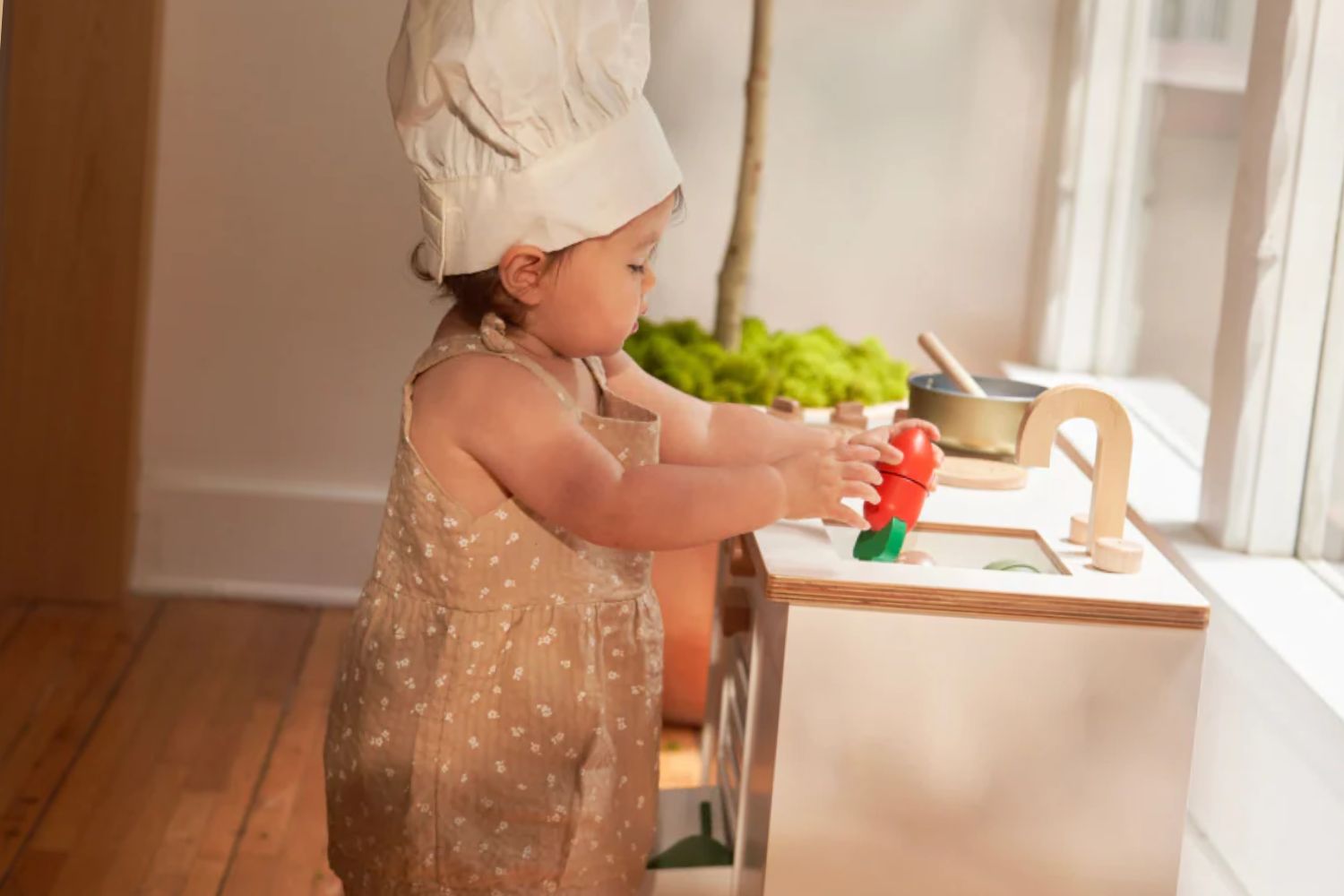Discover the essential benefits that children can get from pretend play with toddlers and learn tips on how to help them engage in this activity.
Pretend Play with Toddlers
As parents, we are always searching for creative ways to keep our toddlers engaged and entertained. Pretend play is a fantastic way of providing educational opportunities for young children while simultaneously fostering imagination and creativity.
Not only does it spur learning through making sense of the world around them, but when done right, pretend play with toddlers can also be incredibly fun!
In today’s blog post, we’re discussing how to make pretend play engaging so you can enjoy quality time with your little one that sparks mental growth as well as sheer joy.
What Is Pretend Play?
Watch as your little adventurer gets lost in a world of make-believe! Whether they’re playing dress-up as fairies or superheroes, hosting a tea party with their stuffed animals, or embarking on a backyard treasure hunt, it’s all a part of the magical world of pretend play.
Pretend play, also known as imaginative play, creative play, make-believe play, or fantasy play, allows children to use language, gestures, and props to create unreal and imaginary scenarios.
It’s an essential tool for your child’s development, helping them understand the world around them while boosting their physical and cognitive growth.
Not only does pretend play provide endless fun for toddlers, but it also encourages social interaction and teaches them about behavior and everyday tasks.
So let your child’s imagination soar and encourage their pretend play adventures – it’s an important part of their growth and development.
The Benefits of Pretend Play with Toddlers

Encourages Creativity and Imagination:
Pretend play allows children to unleash their creativity and imagination without any limits or rules. This type of free-form play can help them think outside the box, expand their ideas, and develop new ways of thinking.
Enhances Social Skills:
Pretend play requires cooperation and communication between children, helping them develop important social skills like sharing, taking turns, and problem-solving.
It also allows them to experiment with different roles and emotions, which can help build empathy and understanding.
Develops Language Skills:
From creating dialogue in their pretend scenarios to learning new vocabulary related to their imaginative play, pretend play is an excellent way for young children to develop their language skills.
Improves Physical Development:
Whether it’s running, jumping, or dancing as part of a pretend game, children engaging in imaginative play are also developing their gross motor skills and coordination.
Boost problem-solving skills:
Watch as they learn and develop their thinking abilities by creatively solving problems. Imagine the excitement as they construct a fort out of blankets and strategize to keep it from collapsing.
Improves self-control and teamwork
Delve into delightful make-believe scenarios and discover the key to resolving role assignments. Navigate through the occasional wave of frustration and empower toddlers and preschoolers to overcome challenges.
Foster strong connections
Building a virtual universe not only unites players but also facilitates understanding and exploration. Parental involvement adds a valuable dimension, fostering exchange and deepening relationships.
Helping children cope with challenging emotions
Through imaginative play, children can navigate and overcome difficult situations such as doctor visits or the first day of school.
When is the right time to introduce pretend play to my child?

The answer is, it’s never too early to encourage the use of imagination in your child. While traditional make-believe games typically start in later toddlerhood, the American Academy of Pediatrics (AAP) suggests that babies are ready to explore different social roles from birth.
This can involve observing your smile or making faces, as well as engaging in back-and-forth conversations where you repeat or respond to your baby’s sounds.
How to Encourage Pretend Play for Babies and Toddlers
From the moment they’re born, your little one has an incredible imagination waiting to be ignited. Discover how to nurture their creativity and keep the fun going all the way through preschool!
0-24 months: Building the Foundation
Even the tiniest ones can participate in social play and begin to explore different roles. Engage in lively conversations, encourage exploration with age-appropriate objects, and sing action songs that invite participation.
Spark conversations: Have captivating chats with your baby and let them explore the objects around them. As they enter their first year, focus on modeling the actions and behaviors they’ll learn as a toddler, like sharing toys and introducing themselves to new people.
Encourage exploration: Provide age-appropriate objects of various sizes, colors, and textures for safe exploration. Your little one can play on their tummy or in a seated position if they’re not yet mobile, or crawl and move around to discover different objects if they’re a bit older.
Sing and act: Engage your baby with action-packed songs and rhymes like Patty-Cake, This Little Piggy, the Itsy-Bitsy Spider, and Pop! Goes the Weasel. Watch with joy as they start imitating the actions and eventually join in the fun.
Lead by example: As your toddler nears 12 months, become a model of the social behaviors you want them to learn. Show them how to introduce themselves and make friends by saying, “Hi, I’m [Name]. Would you like to play together?”
Taking Turns and Sharing: Teach your young toddler about sharing by playing turn-taking games. Switch vehicles while playing with trucks or take turns styling each other’s hair with a brush or comb.
Play telephone: Grab a toy phone and “talk” to family members or friends, inviting your toddler to do the same. Don’t be surprised when you catch them engaged in phone conversations of their own soon after!
Imagination knows no bounds, and with these simple tips, you can inspire your child to dream big and play even bigger. Let the pretend games begin!
Ages 2-3: Spark Your Child’s Imagination with Pretend Play
Watch your child’s imagination bloom as early as age 2! But they may need a little nudge to get started. Don’t worry, we’ve got you covered with some brilliant ideas. Once they’re interested, let them take the lead and join the fun!
Dress-up Fun: Unleash their creativity with dress-up clothes and props. A simple hat, gloves, or jacket can transport them to a world of make-believe. And if there’s a mirror nearby, watch their excitement as they admire their new look.
Role-playing Scenarios: Prepare them for upcoming events or tricky situations through role-play. If they have a doctor’s appointment coming up, play pretend doctor to ease their worries. Or become their school friend who wants to share their favorite toy and teach them how to navigate social situations.
Stuffed Animal Tea Party: Arrange a circle of stuffies and let your toddler play host. Watch their imagination shine as they serve refreshments to their fluffy friends and you. It’s a delightful and educational pretend-play activity.
Unleash Creativity with Objects: Turn everyday objects into exciting items for imaginative play. A hairbrush becomes a microphone, toilet paper rolls transform into binoculars, and a block becomes a delicious slice of birthday cake. Watch the fun unfold as your child invents their own stories!
Animal Dance Party: Get grooving with your toddler and your favorite tunes. But instead of dancing as yourselves, encourage your child to move and groove like different animals. It’s a hilarious and energetic activity that sparks their creativity and gets them moving.
Let your child’s imagination soar with these exciting pretend-play ideas. Get ready to be amazed by their creativity and watch them develop important skills along the way!
Ages 3-5: Spark Your Child’s Imagination
Around her third birthday, get ready for your child to start running the imagination play show. Now that her brain is developed enough to come up with make-believe stories, she’ll take off exploring new roles and scenarios with less prompting on your part. All you need to do is join in her world.
Play into the games: If your child says she’s flying when she’s jumping or stepping over lava that’s just a red blanket, don’t correct her. Just follow along.
Switch Roles: Let your little one take charge as the parent while you become the child. Be sure to follow their lead and follow their instructions (within reason, of course!).
Be chefs: Preschoolers can assist with simple cooking tasks like pouring ingredients into a bowl, sprinkling cheese on a casserole, or using cookie cutters. Invite your child to help out in the kitchen and pretend the two of you are running a restaurant.
The Animal Doctor: Give your child the opportunity to be the doctor, providing check-ups for their beloved stuffed animals. As the assistant, you can help bring new patients to the exam table or assist with other tasks.
The Mail Carrier Adventure: Set up makeshift mailboxes throughout the house or outdoor areas. Armed with a bag of junk mail, your child can become a dedicated mail carrier, delivering important messages to each box.
Your child’s imagination will grow by leaps and bounds during her first few years of life but pretend play is valuable at every age and stage. Start early by feeding your infant’s capacity for social play and make-believe — and watch your efforts pay off in the years to come in the form of a thorough checkup by your “doctor” or a tasty mud cake made with lots of love.
Let the magic of pretend play unleash your child’s boundless imagination and make their early years truly unforgettable.
Tips to Boost Your Child’s Pretend Play
Discover how your support can ignite your child’s creativity and enhance their overall development. Here are some proven techniques to encourage pretend play for your little ones:
Nurture Their Fantasy World
When your child unleashes their imagination, don’t bring them back to reality. Instead, fuel their fantasy by asking questions about their pretend play. For instance, if they’re playing as a superhero, inquire about their superpowers or recent heroic feats.
You might even get an opportunity to join the excitement and become a superhero or villain yourself! This not only makes playtime enjoyable but also aids in language development as you engage with your child.
Spark Your Child’s Imagination with Props and Costumes
Ignite your child’s creativity and let them step into a world of make-believe! Encourage pretend play by providing them with costumes and props that won’t break the bank.
Dig into your closets and grab some old clothes to create dress-up fun. Scarves, hats, and dresses can transport them to a whole new world of adventure!
But it doesn’t stop there. Dive into the world of limitless imagination with a simple cardboard box and everyday objects. Watch as your little explorer transforms it into a pirate ship, a grand castle, or even a rocket ship to explore the moon!
Encourage Building and Creating
Ignite your child’s creativity and problem-solving skills with building and art activities! Provide them with building blocks, construction sets, or art supplies, and watch as they unleash their imaginations.
From towering structures to magical realms, your child will have hours of fun creating their masterpieces. To keep the excitement going, suggest engaging art projects like mask-making or paper finger puppets.
Not only will this type of play enhance their creativity, but it will also improve their hand-eye coordination. Challenge them to build the tallest tower or design a dream home for their dolls. Let their imagination soar and watch their skills soar too!
Unlock Your Child’s Imagination Through Story Time
Looking for a way to entertain and educate your little one? Look no further than the power of reading. Not only does reading to children promote language skills, but it also sparks pretend play and creativity.
Discover a whole new world of characters and adventures through the pages of children’s books. We’ve compiled a list of the best children’s books for toddlers to help you get started. Alternatively, head to the library and immerse yourself in endless possibilities.
Make story time interactive by asking your child thought-provoking questions. Explore their predictions and encourage them to put themselves in the shoes of the characters. Watch as their imagination comes to life, as they act out their favorite parts and even reenact the stories with their friends.
Unplug and Play: Limiting Screen Time
In a world dominated by screens, it’s easy for children to miss out on real-life social interactions and pretend play. But did you know that these activities are vital for their development?
Parents must keep an eye on how much screen time their little ones are getting and understand the potential effects of excessive use.
According to experts, children aged 2 to 5 should have no more than one hour of screen time per day. But when you do allow screen time, why not make it a bonding experience?
Instead of letting your child zone out alone, try watching age-appropriate educational shows together or snuggling up for a fun movie night with some tasty snacks.
By setting limits on screen time and actively engaging with your child during those moments, you can ensure they reap the benefits of both technology and real-life experiences.
Tips for Making Pretend Play Fun & Engaging
Create a Dress-Up Box:
Fill a box with old clothes, costumes, hats, and accessories to encourage your child to change into different characters and explore different roles.
Play Along:
Get involved in your child’s pretend play adventures by joining in as a character or taking on a supporting role. This not only strengthens the bond between you and your child but also promotes their imagination and creativity.
Provide Props:
Props can make pretend play even more exciting for toddlers. From stuffed animals to toy tools, encourage your child to use props in their imaginative play scenarios.
Switch Things Up:
Don’t be afraid to mix things up and suggest new ideas for pretend play. This can keep things interesting and help your child explore different themes and roles.
In conclusion, pretend play with toddlers is more than just a fun activity – it’s an essential part of their development. By encouraging and participating in their make-believe games, you are not only providing them with endless joy but also helping them grow and learn in various ways. So let your child’s imagination run wild, and watch as they discover the magic of pretend play!
FAQs
What are examples of pretend play for toddlers?
An example of pretend play for toddlers could be playing as a superhero and saving the world from villains or pretending to own a bakery and baking delicious treats for customers.
More examples of pretend play for toddlers include playing dress-up, pretending to be different characters or professionals, building structures with blocks, and creating art.
Why is pretend play important for child development?
Pretend play allows children to use their imaginations, problem-solving skills, and social interactions. It also helps with language development, creativity, and cognitive development.
How to pretend play with a 3-year-old?
To pretend play with a 3-year-old, you could provide them with props and costumes such as hats, scarves, and dresses to encourage dress-up fun. You can also suggest different scenarios for them to act out or join in on their imaginative games.
Reading books and asking thought-provoking questions during story time can also spark their creativity and imagination.
Additionally, engaging in outdoor play and incorporating imaginary elements can also make for a fun pretend play experience. Overall, the key is to let your child lead the way and follow their imagination.
What stage of development is pretend play?
Pretend play is considered a stage of development in early childhood, typically between the ages of 12 months to 5 years.
It is an important part of cognitive and social development during this time, as children learn to explore their surroundings and develop problem-solving skills through imaginative play. So don’t be surprised if your child starts pretending to be a princess or a firefighter – it’s all part of their development!
Is pretend play cognitive development?
Yes, pretend play is a crucial aspect of cognitive development for children. It allows them to use their imaginations and problem-solving skills, which are important cognitive functions.
Pretend play also helps children understand cause and effect, develop abstract thinking, and explore different roles and perspectives. So let your child’s imagination run wild – it’s beneficial for their development!
Is too much pretend play bad?
No, pretend play is not bad for children in any amount. It is an important and natural part of their development. It allows them to explore and understand the world around them, develop social skills, and use their imaginations.
However, parents need to ensure that their child engages in a variety of activities, including physical play and screen-free activities, to promote a well-rounded development. So while pretend play should be encouraged, it’s important to find a balance in your child’s daily routine.
Conclusion
From introducing pretend play with dinosaurs and monsters to cooking with real ingredients, this article has discussed several ways in which caregivers can encourage pretend play with toddlers.
Through pretend play, toddlers learn to express their feelings, assist them in developing language and problem-solving skills, improve social communication, and even increase empathy.
As you can see, when done in moderation, ‘pretend play’ is very important for the social and emotional development of your child so why not give it a try?
Show your child that you are willing to explore this world of pretend play and take them on an exciting adventure where memories will be created that will last a lifetime.
And if you need some ideas to get going, just refer back to this article – there’s no shortage of creative activities to choose from! So what are you waiting for? It’s time to start exploring new possibilities with your little one – grab their attention now and begin the journey together!
Thanks for reading our article. If you want to know more information, visit our website here.
Read more:

